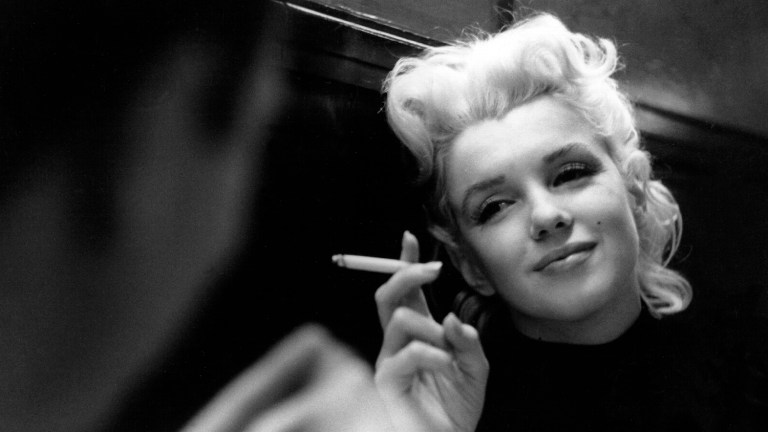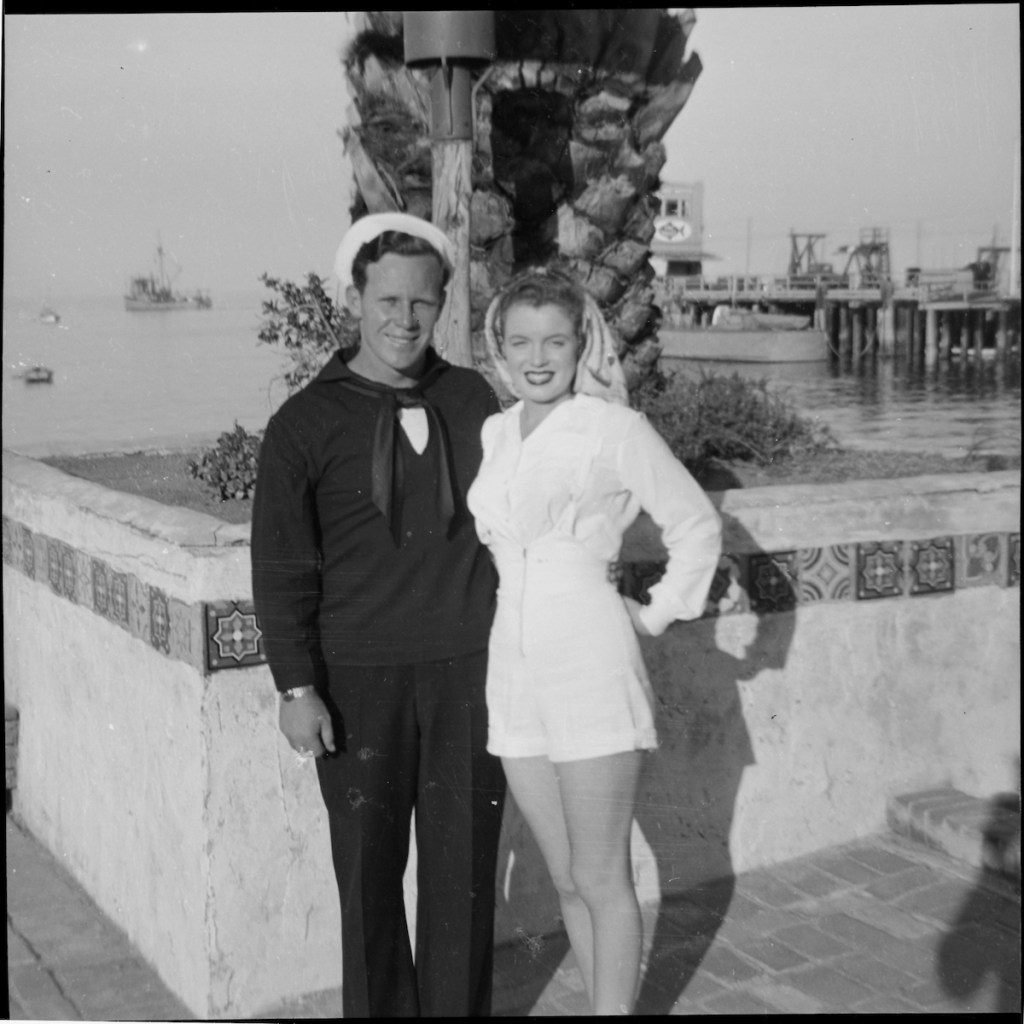How WW2 Turned Marilyn Monroe into a Movie Star
Perhaps the most famous movie star of the 20th century, Marilyn Monroe, got her start building planes during World War II…

Late during an autumn night in 1954, Marilyn Monroe stood above a New York City subway grate at the corner of Lexington and 52nd. As a train passed beneath her feet, and a gust of air rushed ever upward, a smile erupted across her face. Cinematic history was made. The sequence in question was filmed for The Seven Year Itch, Billy Wilder’s exceedingly ‘50s romantic comedy. But while that movie’s antiquated plot has long since faded from memory, the vision of Monroe in the white dress never did.
For many it is the encapsulation of Monroe’s mystique: an innocent (some might even say infantilized) beauty whose sweetness belies blonde bombshell sex appeal. It was a manufactured image, of course, synthesized right down to the platinum hue of Monroe’s hair. In reality, she was a dirty blonde born to the name of Norma Jeane Mortenson. Marilyn was also a woman who chafed at the sex goddess fantasy imposed on her by post-World War II Hollywood and the men who ran it. But there was a time before that movie, and before that fantasy, when Norma Jeane was free. There was a time, during that monstrous war, when her affect was closer to Rosie the Riveter than Jean Harlow.
During the height of the American war effort in the 1940s, the woman who would become Marilyn Monroe spent her days at Radioplane, a munitions factory in Los Angeles’ Van Nuys neighborhood. There she helped build what became the first mass-produced military drones the world would ever know. It was a different kind of life from Hollywood glamor, and yet an argument has been made that she wouldn’t have achieved one without the other. Perhaps Marilyn Monroe would never have existed if Norma Jeane didn’t get the opportunity to do her part in the war, and catch the eye of a military photographer working for Ronald Reagan…
Marilyn Answers the Call
As the U.S. entered the Second World War, Norma Jeane was also in a state of major transition: She was about to marry a neighborhood boy named Jim Dougherty. At the time of the wedding in 1942, Jim was 21 and Norma Jeane had just turned 16. At least initially, both were reluctant about the arrangement. A year earlier, Norma Jeane’s latest and final foster mother, Grace Goddard, had encouraged Jim to take her ward to a school dance. Grace was essentially urging Jim to also take on a wife.
The rationale for this is debated. The Goddard family was preparing to move to West Virginia at the time and did not want to take Norma Jeane with them. However, as Dougherty later told biographers, there was likely a more disturbing reason for this: Grace’s husband “Doc” had sneaked into Norma Jeane’s bedroom when she was 15 and molested her. After becoming Marilyn, Monroe would later tell that story but change the predator to a stranger.
The point was that after a childhood punctured by a series of broken homes, Norma Jeane was essentially passed off from being a child in one household to the child bride of another. But at least, according to Jim years later, the marriage was a happy one in the early months. Norma Jeane never knew her father, and eventually Dougherty took on the role of husband, protector, and father figure to her.
She was so dependent on Jim that she begged him not to join the military at the start of World War II. She feared the idea of losing him and becoming a widow. As a compromise, he convinced her to let him volunteer for the U.S. Merchant Marines. There was irony in this since merchant marines wound up being at arguably greater risk as they continually transported supplies, men, and weapons through enemy waters during the war. Many did not make it home. But for the first two years, that wasn’t a danger since Dougherty became an instructor on a nearby base where Norma Jeane was also allowed to live. Yet in early 1944, Jim was finally deployed into the South Pacific.
While Marilyn would later surmise her first marriage was one of convenience, during those tumultuous days as Norma Jeane, she was one of the only wives to see her husband’s vessel off—he’d be gone for over a year on that first tour. In his wake, Dougherty left behind a very devoted, very physical young wife to live in his parents’ house.
Soon Norma Jeane grew restless. However, one benefit of living with her in-laws turned out to be that “Mama Dougherty” had connections with the Radioplane Company, a war plant down the road that was always looking for more women to work on its assembly line.

A WW2 Discovery
Before the Second World War, Radioplane’s founder had his feet firmly planted in the first global conflict, as well as Hollywood. Reginald Denny, born at the tail end of the 19th century outside of London, made a name for himself as an RAF pilot in the Great War. Afterward, he took his aerial acumen to the U.S. and Hollywood, attempting to give acting a go. During the tail-end of the 1920s, Denny was one of the most daring stunt pilots on films like Howard Hughes’ WWI epic, Hells Angels (1927).
Around this time, Denny also discovered there was a rudimentary market for radio-controlled model airplanes. At first, building model planes was his hobby. Soon it turned into a business, initially as a hobby shop on Hollywood Boulevard in 1934, and then as Radioplane after Denny began overseeing the construction of RP-3 radio planes for the Army in ‘39. The RP-3 was a miniature plane that could be used as target practice by the U.S. Army Air Force pilots. These remote-controlled planes were, in essence, the first military drones. And after the bombing of Pearl Harbor in December 1941, the Army had immediate need for vast amounts of target planes.
When Norma Jeane first arrived at Radioplane, she was assigned with other women to the Chute Room, which is where a line of employees packed parachutes that would be attached to the miniature planes—this way after they were shot down, they could be saved and used again later. But according to biographer Fred Lawrence Guiles, after a month of packing tiny parachutes, Norma Jeane asked to be moved to another department that would be less monotonous. So she was transferred to the “Dope Room” where a liquid plastic was sprayed over the cloth that would become a target plane’s fuselage.
Norma Jeane did not make friends with the other women at Radioplane, but she experienced her first taste of autonomy—of living as an adult without a parent or parental husband looking over her shoulder. She also earned a certificate of commendation from her supervisors for demonstrating zeal on the job while in the Dope Room.
She made an impression on her supervisors, and perhaps on Radioplane founder and former Hollywood actor/stuntman, Reginald Denny. For it was Denny who called the First Motion Picture Unit based at the old Hal Roach Studios (colloquially known as “Fort Roach”) to suggest that the women working in his plant were entirely photogenic and exemplary symbols of the war effort.
The Motion Picture Film Unit was the propagandistic marriage between the military and Hollywood during World War II, and in Burbank one of its higher ranking officers was Ronald Reagan, an enlisted man who was still making the occasional movie while also wearing his uniform. It was Reagan whom Denny encouraged to send over a photographer, and it was Reagan who tasked photographer David Conover with the job.
Conover later claimed he discovered Marilyn Monroe. When he arrived at the Radioplane plant in late 1944, he was immediately drawn to Norma Jeane and asked if she would become a model for the day. She enthusiastically said yes, and her foreman had the bright idea to move her away from the dope to the more photogenic floor where they built engines. There Conover took photos of Norma Jeane “installing” a drone plane’s propeller. After lunch, he convinced her to pose outside the factory as well for some “sweater pictures.”
The photos taken by Conover were for the strikingly named Yank magazine, a military periodical written by and for enlisted men. However, even before the photos were published, Conover claims he was told by the film developer that the woman in them was a real “humdinger,” as Karina Longworth’s You Must Remember This podcast. Afterward, Conover proposed that Norma Jeane quit her job and join him for a “photographic safari” in the country that could become her model’s portfolio.
Norma Jeane did not initially quit Radioplane outright, but she called in sick after taking more photos with Conover and later joined the Blue Book Model Agency. In short order, she became one of Blue Book’s most requested models and left Radioplane for good. She was barely 19.
The Beginning of Marilyn
The woman we call Marilyn Monroe might have had a different life if the Second World War had never occurred. Like most women in her generation, Norma Jeane was conditioned to believe the pinnacle of her life was to be a wife and mother. In fact, she was married off before she was an adult.
Yet the war gave her opportunities and freedom. It was a chance to be her own woman. She never exactly spoke ill of her first marriage. Indeed, Jim and Norma Jeane were reportedly quite close during his first two weeks of leave from the merchant marines in 1945, spending the first weekend entirely inside a hotel room. But by the end of that leave, Dougherty recalled the following about that last night in Fred Lawrence Guiles’ biography, Norma Jean: The Life of Marilyn Monroe:
“It was just sad, very sad. Sad for me because I didn’t want to leave her, and sad for her because each time I left, it was a destructive thing that hit her extremely hard. She wanted something, someone that she could hold onto all the time.”
That might be true, but by the time his second leave came around, he wasn’t even able to see Norma Jeane. As her aunt (whom Norma Jeane moved in with as her modeling career took off) told Jim over the phone, “She isn’t home very much.”
In 1946, Norma Jeane would divorce Jim. It was the same year she changed her name to Marilyn Monroe.
